-
 517855 Hits
517855 Hits
-
 100% Score
100% Score
-
 336 Votes
336 Votes
|
|
Mountain/Rock |
|---|---|
|
|
32.65335°S / 70.01149°W |
|
|
22841 ft / 6962 m |
|
|
Overview
Aconcagua is the highest mountain in the Western hemisphere, located in western Argentina, near the Chile border. There are about 3,500 climbers trying the summit each year (info from 2002). The 'Normal Route' is non-technical - a walk-up, following the Northwest Ridge. It is the altitude that poses the biggest problem. That and the sense that this is an easy climb. Every year people die because or inexperience and/or they underestimate the task at hand. Respect this mountain and you will fare better. You should not attempt alone, you should always have someone watching you. Much of the hiking is on scree.
On the Normal and Polish Traverse routes there are no permanent snowfields, but crampons and ice axe may still be required in some sections. The Caneleta can have hardpacked snow with some icy sections that can be easily cramponed making the top section much quicker (in relative terms). So be warned many who neglect to bring crampons are turned back by these conditions.
Getting there and currency issues, customs
Fly to either Santiago (Chile) then Mendoza (Argentina). Or Buenos Aires then Mendoza. Take the bus to Puente del Inca or Penetentes. The entrance to the National Park is either at Puenta del Inca (normal route and south face). Or the through the Vacas Valley near Penetentes (For the Polish Glacier, Polish Traverse and Vacas routes).Permits
Permits 01/01/2025- Climbing USD$ 1,140 - 20 days
- Long Trekking (note as of 2025) - 7 days trekking is no longer allowed on the Vacas route. (I found out the hard way)
LOW SEASON: From November 15th to December 14th 2024 to February 21st 2025.
- Climbing USD$ 880 - 20 days
Normal Route/Plaza des Mulas (Horcones Valley)
HIGH SEASON: From 15th December of year 2025 to 31st January 2025, a permit costs:
- Climbing USD$ 950 - 20 days
- Long Trekking USD$ 310 - 7 days
- Short Trekking USD$ 160 - 3 days
LOW SEASON: From November 15th to December 14th 2024 and from February 21st 2025
- Climbing USD$ 730 - 20 days
- Long Trekking USD$ 260 - 7 days
- Short Trekking USD$ 130 - 3 days
- Permits are valid from the date of entry to the Park
- Argentine citizens are entitled to a 50% discount on the above prices.
Permit / garbage information from: Corax Date: Feb 05, 2008 11:26 PM
The following is to be found on the back of your climbing permit:
You will have to pay a U$S 100 fine if you:
- Do not use the washrooms provided by the park.
- Throw garbage along the park, leave or do not use the numbered plastic bags provided by the park.
- Pollute rivers, streams or waterfalls.
- Enter either with bicycles or pets.
- Damage wildlife, plants and natural, cultural or archeological features that are protected by the park regulations.
You will have to pay a U$S 200 fine if you:
- Throw garbage, forget or loose the numbered bags in the high camps or during your expedition.
- Gather or burn wood in the park.
- Carve inscriptions in the stones.
You will have to pay the equivalent of a 2nd permit or an ascent permit if you:
- Go beyond the limits of the length of the stay allowed in the permit or go higher than 4300 mts with short trekking (3 days), long trekking (7 days).
Note:
- The maximum stay is 20 days with ascent permit.
- Horcones ranger station open daily from 8 A.M. - 6 P.M.
- For your safety always check out.
On matters of poop n scoop
When arriving in Plaza de Mulas and Plaza Argentina when you check in the Ranger will register you and hand over a numbered "shit-bag". This bag will be your companion all the time on the higher reaches of Aconcagua and if you lose it you have to pay a $200 fine. You're supposed to use the bag as the only alternative for a toilet and if you're doing your business in nature and are spotted by the guards there is a $100 fine. Be warned, the plastic of the bag is not that thick and is not to be trusted. Double or triple pack it in order to avoid quite disgusting leakage in your backpack. The best thing is to bring a number of smaller bags with you and bag it each time. Cache these smaller bags which should freeze overnight. You can then double bag these in the numbered bag for safer transportation to base camp. Your mule provider is in charge of making sure you have brought this and your numbered garbage bag down to base camp. If you lose it he won't sign your permit. If he does then he becomes responsible.
There are toilets at Pampa Lena (flush!), Casa Piedra and Plaza Argentina. Conflencia and Plaza des Mulas for the normal route. So it is in the upper camps where you will have to collect your waste.
If not part of an organized expedition, you have to "be contracted to a toilet service" at BC. Asking around a bit and some big organizers will tell you the price is US$100, some smaller US$5/day or US$10 for the whole stay. If you used the toilet services between 20:00 and 08:00 you may not have to pay anything in some of the places. For those on an extremely low budget, an alternative is to camp at the restaurant and use the toilets there. You can always use the restaurants' toilet if you are giving them some business.
Here is a Map of the City of Mendoza Mendoza map
Guiding Companies, Mules and weight of gear
There are many groups that guide Aconcagua here are just a few.
Mountain Travel/Sobek Mountain Travel Aconcagua Trip
Skreslet Adventure Services web https://laurieskreslet.ca/services/aconcagua/
Field Touring Alpine Field Touring Alpine Aconcagua trip
Alpinistica Web: http://www.alpinistica.com E-mail: admin@alpinistica.com
Expedition Aconcagua: http://www.alpinistica.com/expedition-aconcagua.html Aconcagua Alpine Style: http://www.alpinistica.com/alpine-style.html
INKA Expeditions Contact info: Juan B. Justo 343 - Ciudad (5500) - Mendoza - Argentina Tel / Fax: ++54 261 4250871 E-mail: inka@inka.com.ar web: www.inka.com.ar Aconcagua Trip
Fernando Grajales Expeditions Fernando Grajales Expeditions TelFax: 54-261-4283157 Cell: 549-261-(15)5007718/9 Toll free: 800-516-6962 www.grajales.net
Osvaldo Carbajal of Lanko-altas montañas Villa Los Penitentes, Mendoza, Lanko-altas montañas www.lanko.com.ar e-mail: info@lanko.com.ar expeditions, porters, mules, base camp, etc Telephone numbers: 00-54-261-4443486 00-54-261-4322291
Aconcagua Expeditions www.aconcaguaexpeditions.com Ruta Panamericana 8795 La Puntilla - Mendoza - Argentina E-mail: info@aconcaguaexpeditions.com Telephone: ++54 9 261 5940872 (outside Argentina) 0261 155940872 (from Argentina, outside Mendoza) 155940872 (from Mendoza) Miguel Zubeldia (Ceo)
Adventure Peaks Adventure Peaks UK 101 Lake Road Ambleside Cumbria LA22 0DB Telephone: +44 (0)15394 33794 Fax: +44 (0)15394 33833
Cosley & Houston Aconcagua trip
AEA Expeditions www.aeaexpeditions.com Expeditions and trekkings in Aconcagua, Pissis, Tupungato, Mercedario Maipo and Cordon del Plata. Logistic support for expeditions and professional high mountain guides. The company is based in Argentina. Phone +54 + 261 15 - 5947613 Int : +54 +261 95947613
Natural High Natural High
Alpine Trekking organizes mountaineering expeditions in South America and is specialized in Aconcagua. Alpine Trekking
7summits Aconcagua trip http://7summits.com/aconcagua/trips.php
Aymara Adventures and Expeditions http://www.aconcaguaaymara.com/ e-mail: info@aconcaguaaymara.com Address: 735 España Avenue -Mendoza- Argentina Phone: (++54) (261) 424 4773 From London, the Uk - +442071930268 From San Diego, California, the USA – +16195734062
Ganesh Adventures Aconcagua trip http://www.ganeshadventures.com
Mules Each mule can only take 60 kilos (two 30 kilo bags balanced). So each duffle you bring should not exceed 30 kilos. As a rule clients are allowed 30 kilos including their food. Not including tents and communal gear. You will be charged two days in and one day back for the walk in in the normal route. For the walk out, it will depend on whether you hire mules who just brought gear in or if they came in empty just for you. Try to negotiate in advance for dropoff and pickup. Radios are useful here and the Rangers can be of great help. For the Polish side you will be charged 3 days in and one to two days out for the approach and its the same story for the walk out as on the normal route.
Mule prices can vary but it works to about 150 USD perday for and mule driver and two mules (120 kilos). This is only a guide things change depending on how desperate you are and availability, size of group. Eight people would use 4 mules (2x30 = 60 kilos per mule) plus probably 2 mules (2x60 kilos of communal gear). You would probably have three muleteers.
Just an example for the Polish Traverse - Group size - 3 people. December 2001 it cost for two mules in (three days) and one mule out (two days) including the Mule driver $ 750$US
Some Mule providers
- Rudy Parra E-mail: rudy@lanet.com.ar or aconcagua@rudyparra.com
- Fernando Grajales Expeditions Fernando Grajales Expeditions TelFax: 54-261-4283157 Cell: 549-261-(15)5007718/9 Toll free: 800-516-6962 www.grajales.net
- Osvaldo Carbajal of Lanko-altas montañas Villa Los Penitentes, Mendoza, Lanko-altas montañas www.lanko.com.ar e-mail: info@lanko.com.ar expeditions, porters, mules, base camp, etc Telephone numbers: 00-54-261-4443486 00-54-261-4322291
- Daniel Alessio Casilla de Correos 33, 5505 Mendoza, Fax: 54-61-962201, E-mail: alessio@lanet.losandes.com.ar, Home phone# 054-261-4962201.
Buying equipment in Mendoza There are now many shops to purchase equipment that you may be missing upon arrival in Mendoza. Orviz is one that has a web site www.orviz.com
When to climb and guide books
The best climbing time is from December (colder but less crowded) to February (Jan/Feb possibly better weather but more busy).
Guide Book Aconcagua, a climbing guide by R.J.Secor, (1994)
Video "Aconcagua: The Roof of the Americas" from Media Ventures www.adventure-video.com
A brief description of 33 routes is available on Aconcagua Expeditions website www.aconcaguaexpeditions.com
7summits Guidebook http://7summits.com/aconcagua/guidebook.php
Camps and possible itineraries
There are 5 routes listed on the left-hand side of this page. This section deals with the two most traveled, The Normal Route and the Polish Traverse.
20-12-06 Note the Quanaco route is reported to be closed to the public.. More on this as news filters in. The reason given so far is the perserve this unspoiled portion of the mountain.
POLISH TRAVERSE If you go the Polish traverse route, allow three days at least for the approach. Here is how it can go. You can alter as you go depending on how you feel.
Possible itinerary
- Day one- End of Vacas valley-Pampa laina (8,200 ft) From the road to camp 4-5 hours
- Day two- Casa Piedra (9,200 ft) 5-7 hours
- Day three- Plaza Argentina (13,200 ft) 5-7 hours
- Day four- Rest
- Day five- Carry a load to camp 1 (16,200 ft) 4-6 hours
- Day six- Move up to camp 1 4-6 hours
- Day seven- Rest
- Day eight- Carry to camp 2 (19,200 ft) (high camp) 4-6 hours
- Day nine- Rest
- Day ten- Move up to camp 2 (19,200 ft) 4-6 hours
- Day eleven- walk to 21,500 feet Independencia to understand the route 2-3 hours
- Day twelve- get up early 3:00am and start for the summit with headlamps and crampons this is a long day allow 10-12 hours or longer for the round trip. 7-12 hours
- Day thirteen- descend to base camp then arrange mules with the rangers for your gear and walk out to Casa Piedra to spend the night. 3-7 hours
- Day fourteen-walk out to the highway at mouth of the Rio Vacas have you pick up scheduled in advance and have the rangers confirm it if possible. If not you will have to walk or hitchhike (which is difficult since it is so close to the border). You can always call the hotel at Penitentes from the truck customs building at the mouth of the Vacas. They will pick you up if you will stay or eat there. So have the number tucked away. 4-8 hours
On the Polish route, once you have reached basecamp at Plaza Argentina 13,300 feet (takes 3 days to reach). Then it's up to camp one at approx 16,200 feet. The next camp, Camp 2 is at 19,200 feet approx. From here you can go up the Polish Glacier or traverse over to the normal route at Independcia (21,500) and up to the summit. A camp is also possible at White rocks, approx 19,900 feet. This will aid you in removing the traverse at the beginning of your summit bid. But will take extra energy carrying all your gear over the traverse and setting up another camp. I don’t recommend it. I only mention it as some people do it. Camps 1 and 2 are not huge and space can be an issue at times. There is a larger flat area down to the right as you enter camp 2. Many people go there. But it is more exposed, so you had better make your tent extra bombproof.
Possible traverse submission by author: mconnell If you are going to do the "Polish Traverse", consider going out the Normal Route. It means you have to do a carryover of everything, but you get to see both sides of the mountain and can be out from high camp in 2 days. From Camp 2 at the foot of the glacier, traverse directly to White Rocks and head down. Took us about 4 hours from White Rocks to Plaza de Mulas. From William Marler. Yes this can be done but we haven't as yet as our groups have always brought more gear than was needed. ie food and extra clothes that were left in Plaza Argentina. As well as all the garbage including fuel canisters you have used up to base camp and above that you have to bring out with you. So we would have had to bring all that extra gear up and over the mountain. If you are a small tight group with your act together go for it. But bring all your garbage.
NORMAL ROUTE
On the Normal route, a two-day walk (overnight at Confluencia) will get you to a large basecamp (Plaza de Mules 13,500 feet approx). Stay on the left side as you enter camp (many loose boulders make there way down on the right side). Then up camp 2 or Camp Canada at 16,200 approx. This is a good acclimatization stop but has limited space sometimes. Some people continue up to Nido des Condores (approx 18,000 feet) which is a large area but can be very exposed to the wind and elements. It is also a very big push from basecamp at 13,500 feet and can break a lot of people. Camp 3 is at Berlin (19,300 feet approx). From here you can go to the summit easily if you have acclimatized well. I use the word easily loosely, most of you will know what I mean. Nontechnical but a real slog in scree.
- Possible itinerary
- Day one- Puenta del inca to Confuencia.(9,200 ft) 3-4 hours
- Day two- Confluencia to base camp. (13,000 ft) 6-7 hours
- Day three- Rest day
- Day four- Carry to Camp Canada (16,000 ft)4-6 hours
- Day five- Move up to Camp Canada 4-6 hours
- Day six- Rest day
- Day seven- Carry to Berlin (19,100 ft) 5-6 hours
- Day eight- Move up to Berlin (19,100 ft) 5-6 hours
- Day nine- Rest day and trail exploration 2-3 hours
- Day ten- Summit day 8-12 hours round trip 8-12 hours
- Day eleven- Clean up camp and decend to basecamp.3-4 hours
- Day twelve- Arrange mules and walk out to Puenta del Inca or Confluencia 6-8 hours
- Day thirteen- Walk-out if you camped at Confluencia 2-3 hours
Note: Add extra summit days for bad weather.
Author: Alpinist Date: Dec 30, 2005 12:30 PM The conditions at Camp Berlin were quite poor when I was there in December 2005. There was human feces and toilet paper under every small rock, garbage everywhere, and the strong smell of urine in the air. As an alternative, consider camping at Camp Coléra. It is only ~200 feet (70 meters) higher than Berlin and much cleaner. Upon arrival at Berlin, take an immediate left. Follow the trail that traverses the ridge towards the black rocks near the top.
- From Seven Summits my 7 summits pages for more info, a complete trip report and 80+ pictures of the mountain.
Possible food list
What food to bring? Basically it boils down to what you can carry and prepare easily. Also what you feel your body will crave and digest when (as in most cases) your appetite diminishes as you gain altitude.
Here are breakfast, lunch and dinner suggestions
Breakfast Bag of cereal Milk powder Box of raisins Small tinned fruit Piece of cheese Hot chocolate or coffee or tea Breakfast bar granola
Lunches Granola bar Chocolate bar Bag of mixed nuts Piece of cheese Crackers Tin of salmon or tuna or ham or sardines Cookies Juice crystals
Dinner Cup of soup(s) Japanese noodles Freeze-dried dinner Tin or foil pouch of beans Small tinned fruit CookiesTea or Hot chocolate
Snacks Granola bar Chocolate bar Peanut Butter tubes Bag of mixed nuts Piece of cheese Cookies Dried apricots or similar Pringles chips Honey tubes Power bars Cliff bars Squeeze gels (Energy)
Local food for the walk to base camp Bread or rolls Summer sausage Cheese Hard-boiled eggs Oranges and Apples
The next chore then is organizing your food into logical packs for transporting to base camp and each of the higher camps. The following is what I use as a guide for doing the False Polish route. It is a guide only as I add or subtract according to clients' preferences.
Pack 1 for walk-in Three Breakfasts (Pampa Lenia) (Casa Piedra) (Horse Fly/Intermediate camp)
Three Lunches and Snacks (way to Pampa Lenia) (way to Casa Piedra) (at Horse Fly/Intermediate camp)
Three Dinners (Pampa Lenia) (Casa Piedra) (Horse Fly/Intermediate camp)
Supplemented by fresh produce Bread or rolls Summer sausage Cheese Hard-boiled eggs Oranges and Apples
Pack 2 Basecamp Three Breakfasts (Basecamp) (Basecamp) (Basecamp)
Three Lunches and Snacks (on carry to camp one) (on carry to camp one) (at camp one)
Three Dinners (Basecamp) (Basecamp) (Basecamp)
Pack 3 Camp 1 Three Breakfasts (Camp one) (Camp one) (Camp one)
Three Lunches and Snacks (on carry camp two) (on carry camp two) (on move to camp two)
Three Dinners (Camp one) (Camp one) (Camp one)
Pack 4 Camp 2 Three breakfasts (Camp two rec) (Camp two summit) (Camp two descend day)
Three Lunches and Snacks (on rec to Independencia) (on summit day) (on summit or decend)
Three Dinners (Camp two) (Camp two summit) (Camp two summit day 2)
Pack 5 Walkout One breakfast (Casa Piedra)
Two Lunches, Snacks (on walk to Casa Piedra) (on walk out to road)
One Dinner Dinner for one night (Casa Piedra)
On both sides of the mountain that are mainly used (I don't know about Plaza Francia), there are those who provide food for a price. These may include papas frita, omelets, pizzas, different casseroles, and lasagnas. These can be a wonderful addition to one's diet and well being. But a word of caution. While I have had many a great meal and suffered no ill effects. Some people have come down with intestinal problems after partaking in some of these feasts. Basecamps are dirty places and while the food providers do their utmost to keep things sanitary slip-ups do happen. These Food tents are usually available starting mid-December.
Bon appetite!
Mountain Conditions
Up to date weather conditions can be found at Aconcagua Now.
For a good topographic map click here. https://caltopo.com/m/5DCC
More information:
- aconcagua.org
- Aconcagua.com
- peakware.com
- bielefeldt.de/aconhe
- Skreslet Adventure Services
- Mendoza weather
Aconcagua records
Here are some records from the Aconcagua.com web site
- FIRST Ascent First assent of Aconcagua was led by the English alpinist Edward Fitz Gerald, during the summer of 1897. Fitz Gerald's group acceded to the stony slope of the Northwest side of the mountain after following upstream the Horcones River. After several tries, the Swiss Mathias Zurbriggen reached alone the summit the 14 Th. of January, 1897. Followed a few days later by Nicholas Lanti and Stuart Vines, members of the same expedition, made the second climb following the same route.
- FIRST ARGENTINE Ascent Lieutenant Nicholas Plantamura of the Argentine Army reached the summit the 8th of the 1934 in company of the Italian alpinists P Ceresa, P Ghiglione, R Chabod and the Chilean rancher Mariano Pasten. They climbed along the normal Route.
- FIRST Ascent OF THE POLISH GLACIER In March 1934, The Polish V. Otrowski, K Narkiewicz, S Daszinski and S Osiecki opened a new route to the summit along the beautiful Northeast Glacier, doing also the eighth assent of the mountain. Since then the glacier is called the Polish Glacier.
- FIRST Ascent BY A WOMAN Adriana Bance from France, on the 7th of March, 1940, accompanied by Jorge Link from Germany and the members of del club Andinista Mendoza, Pablo Franke, P Etura, D López y J Semper.
- FIRST Ascent OF THE SOUTH SUR It was done by the French Adrienne Bance, the 7th. of March 1940, in company of the German Lopez Link and Members of the Andinist Club of Mendoza, Pablo Franke, P Etura, D Lopez and J Semper
- FIRST Ascent OF THE SOUTHERN SUMMIT The German T Koop an L Herold reached the Southern Summit of the Aconcagua in January 1947. They followed the Normal Route until the middle of the Canaleta , then they turned to the right (west).
- FIRST WINTER Ascent By the normal Route the Argentines E Huerta, H Vasalla and F Godoy made the first winter climbing between September 11th and 15th of 1953.
- FIRST CLIMB OF THE SOUTH WALL The very important first climb of international renown was done by the French Paragot,Poulet,Dagory,Berandini,Lesseur and Denis. At the end of February 1954 they reached the summit after seven hard climbing days.
- FIRST Ascent OF THE EAST GLACIER (ENGLISH GLACIER) February 1978 climbing in alpine style, the Argentines Vieiro (+), Porcelana (+) and Jasson, opened a new route to the summit with important technical difficulties. It is called Argentine Route.
- FIRST TRAVERSE FROM THE SOUTHERN TO NORTHERN SUMMIT During the winter of 1980, the Catalans Serrat and Villena with a support team reached the summit by the Polish Glacier. They used skis on the major part of the itinerary.
- FIRST DESCENT IN A DELTA WING. The prestigious French alpinist J M Boivin Flew a double plaza delta wing with L Marchal, descending in 30 minutes to Plaza de Mulas. They climbed three times to the summit until the climatological conditions were acceptable for the flight. This was in January of 1981.
- FIRST SOLO CLIMB OF THE SOUTH WALL. The French Ivan Girardini, in four days, following the French Route/54 and taking the Messner's variation, reached the summit in January of 1981 making this remarkable first.
- FIRST WINTER CLIMB OF THE SOUTH WALL A Japanese expedition made this difficult and hard first ascent in august 1981. Hasegawa reached alone the summit after choosing the Messner's exit.
- FIRST FEMALE CLIMB OF THE SOUTH WALL The northamerican Titonne Bouchard and her husband, following the French 54/ Messner Route climbed the South Wall, becoming the first woman in ascending this difficult face of the Mountain.
- FIRST DESCENT IN PARAPENTE. The 11the of February of 1985, the Captain of the French Air force, A Steves, unfolded his light parapente about 200m below the summit. By catching ascending currents he went up about 20 meters above it. He arrived to Plaza de Mulas 25 minutes later.
- FIRST LOCAL CLIMB OF THE SOUTH WALL. The Mendocinian D Alvarez, M Sanchez, D Rodriguez, the Colombian M Barrios and Alejandro Randis, reached the summit the 23 of February of 1986. The climbing was done in alpine style following the original French/54 route.
- FIRST DESCENT OF THE SOUTH WALL WITHOUT USING ROPES The strong Slovenian alpinist Slavko Sveticic descended in ten hours from Del Guanaco Col until Plaza Francia without carrying a rope. Previously he climbed with M Romic a new variation of the Southwest Ridge, making the first ascension of the Aconcagua's Pyramid (6000m) by the South Pillar. January 1988.
- FIRST CLIMB OF THE WEST WALL.A team from Mendoza, brought together by Daniel Rodriguez, achieve the climbing of this wall in four days. The route goes through the center of the great wall of 2800m and end in the Southwest Ridge, very close to the Southern Summit. They survived some steep ice avalanches and difficult rock passages.
- FLASH CLIMBS OF THE NORMAL ROUTE.
- January 1987 - L Cichy, Poland 9 hours
- January 1987 - Alejandro Randis, Argentina 8,7 hours
- February 1987 - D Alessio, Argentina 7,48 hours
- February 1987 - M Sanches Argentina 6,32 hours
- January 1989 - M Dacher, Germany 6,15 hours
- January 1989 - M Smith , USA 6,13 hours
- January 6, 1992 - D Porsche, Germany 6,30 hours.
- January 8, 1992 - D Porsche, Germany 5,45 hours.
- January 10, 1992 - D Porsche, Germany 5,30 hours.
- January 12, 1992 - D Porsche, Germany 5,15 hours.
- February 24, 2003 - Christian Stangl - 4h 37 min - www.skyrunning.at
- March 4, 2003 - Christian Stangl - 4h 25 min - www.skyrunning.at
- December 23, 2014 - Killian Jornet - 12h 49min round trip - https://www.mountainiq.com/kilian-jornet-aconcagua/
- February 19, 2015 - Karl Egloff - 11h 52 min round trip - https://www.mountainiq.com/aconcagua-fastest-ascent/
- FIRST ASCENT OF THE TWO SUMMITS IN ONE DAY. The 6th of February of 1991, Alejandro Randis accomplished this climb of the two summits in one day departing from Plaza de Mulas and returning to the same place. Total Time, base camp +Southern summit + Northern summit + Base camp : 14 hours.
- FIRST CLIMB OF THE POLISH GLACIER IN ONE DAY In February 1992, the climber Miguel Lito Sanchez, From Mendoza, became the first alpinist to climb the Polish Glacier departing from Plaza de Mulas and returning to the same place ( by the normal route ) in the same day.
- FIRST ASCENT OF THE "VIA DE LOS GUIAS MENDOCINOS" In February of 1994 R Gabrielli (last governer of The Province of Mendoza); A Lafalla (present governor of the Province of Mendoza); J. Guiaquinta; D. Alvarez; C. Santilli; D. Rodriguez; O Brusadin an Alejandro Randis opened a new Route that is situated at the right of the "Gran Acarreo".
Avoiding Altitude sickness
You should be prepared for the possible onset of altitude sickness. High altitudes are stressful on the body, and lack of oxygen up high can produce slightly debilitating effects, such as fatigue, headaches, shortness of breath, loss of appetite, nausea, and a drunken gait. Altitude sickness generally doesn’t occur below 10,000 feet, but people have suffered its symptoms lower than 8,000 feet.
There’s not much you can do to prevent this problem, but there are ways of alleviating its effects. The key to doing this is simple: take it easy. Take a day or two before beginning the walk in to acclimatize yourself to the elevation. Go at your own pace, and don’t take chances. Even if you’re in excellent shape, don’t be fooled. The lack of oxygen at such high altitudes can definitely throw your lungs for a loop. Walk at a comfortable, slow pace and don’t carry too much weight. Make sure to hydrate yourself regularly, drinking 4 to 5 liters (Nalgene bottles) of water per day; camelbacks can be mountain companions because of their convenient water portability. The only problem being keeping the nozzle clean, I find they can get gross and need constant cleaning.
My self, I attach a 1 liter Nalgene bottle to each side of my backpack so that I can reach them easily without removing my pack. Taking antioxidant vitamins (A, C, and E) also helps reduce the effects of high altitudes. Of course, working out before you go is another great preventative measure. While this doesn’t guarantee an easier time when up high, it can enhance your lungs’ ability to cope with the challenges of high elevations.
Try to spread out your ascent over a period of two or three days to give your body more time to adapt. Play by the “climb-high, sleep-low” theory of ascent: go on a short hike to a higher elevation, then return to the (lower) elevation at which you’ll sleep. Physical fitness, as mentioned above, is no guarantee against developing altitude sickness. Past excursions to high elevations without developing symptoms is similarly no guarantee against getting sick. There’s no way to predict who is more susceptible to altitude sickness although trekkers who overexert themselves, those who are panting or breathless, and those who stagger far behind the rest of the group are likely candidates.
Surefire signs of impending illness include extreme fatigue, headache, loss of appetite, and shortness of breath. If you experience any of these symptoms, the best thing to do is take a break from climbing for a couple of days to acclimatize. Once the symptoms disappear, it’s safe for you to continue. If the symptoms persist or get worse, you should descend to a lower elevation.
More serious levels of the illness include increasing tiredness, severe headaches, vomiting, and loss of coordination, and are indicative of acute mountain sickness (AMS). If such symptoms appear, don’t hesitate to get immediate medical attention. If serious symptoms go ignored for more than 12 hours, they could have dire--even fatal--effects, such as accumulation of fluid in the lungs or brain. The most important symptom of AMS is loss of coordination.
If someone staggers or walks in a drunken gait, check them out for further signs of AMS. A good test is, essentially, the police’s test for drunkenness--ask the person to walk in a straight line, placing one foot directly in front of the other without staggering or losing balance. If the person cannot perform, he or she should descend immediately--and never alone. Go slowly and without exertion, and ideally while it’s light outside. The descent should continue until symptoms begin to decrease; relief usually occurs within 1,000 to 1,500 feet.
There are prescription drugs out there that you can take for severe symptoms. The most common is called Diamox; it works by stimulating your breathing. Diamox is a strong medication and has some slight side effects, such as an annoying tingling in the fingers and toes. You will urinate more frequently so getting out of the tent at night in a storm could be a problem (if you don’t use a pee bottle). This will also necessitate you drinking more fluids to compensate. Do not take more than prescribed (some people get really sick), while I avoid taking it, many people find it helps them. My suggestion would be to try it out at home before you head to altitude so you will get to know the symptoms and side effects beforehand. Then when you take them up high you will have a better understanding of what it is that is making you feel this way.
Equipment list
Partial Equipment list info: Here is a brief incomplete list for you. Minus the Climbing gear
- 6-pairs socks
- 6-underwear
- 2-pairs of shorts for the walk-in
- 3-T-shirts for the walk-in
- 2-bandanas or a sun hat to keep off the sun
- Sunscreen, sunscreen, sunscreen plus zinc
- Good sturdy hiking shoes
- 1-sleeping bag (as warm as you can get)
- 1-sleeping pad (your choice the more comfortable you are the better you sleep the more energy you will have) you can get a Crazy Creek chair that goes with your pad this is a good investment.
- 2-expedition weight Patagonia long underwear tops (or 1 depends on how dirty you like to be)
- 1-expedition weight Patagonia long underwear bottom (or similar)
- 1 lightweight fleece bottom
- 1-heavy weight Patagonia or similar fleece jacket
- 1-Gortex shell jacket
- 1-Gortex shell pants (full-length zippers)
- 1-Down filled jacket liner from Feathered Friends of Seattle, (optional but I always end up using it)
- 1-Down-filled Gortex guides Parka 1-Warm hat with ear flaps
- 2-pairs of heavy duty mittens (in case you lose one pair up high)
- 1-pair fleece gloves 1-pair ski gloves
- 1-pair of Koflach double plastic boots, One Sport (warmer)($$) or Asolo (I prefer Koflach, I find them more comfortable)
- 1-pair of gaitors
- 1-pair ski/trekking poles
- 1-ice axe (If you are doing the Normal route or Polish Traverse this will only be needed for digging level tent platforms. One per tent group would be sufficient)
- 1-pair of sharp crampons (test them on your boots before you leave and make sure they fit perfectly)
- 1-headlamp with extra batteries and bulbs
- 1-cup with spoon attached
- 1-Swiss army knife
- 1- stove of your choice (I use Markhill stormy hanging stone with Blueway cartridges, you can get fuel in Chile or Argentina as it is difficult to fly down) allow 10 canisters per 2-man tent. You can also get white gaz easily.
- 1-tent (you can bring two if you wish and leave one set up at base camp in case one of you has to stay down for any reason.
- food for 12-15 days. If in doubt go with less rather than more as your appetite will decrease at the higher camps. You can fo a price purchase food at basecamp after January 1st.
- Three 1-litre water bottles each (drink at least 5 liters a day to help acclimatize)
Hotels
Hotel Nutibara The Hotel Nutibara in Mendoza is a good bet, you can find cheaper and more expensive lodging but the pool is the best. 2005 rates below. They may allow you to store gear at the hotel and understand climbers' needs (ie will help you get in touch with mule providers). Hotel Nutibara What’s ap +54 261 270 0472
2025 HABITACION SINGLE DOBLE (Single-double room) ALTA ESTÁNDAR $ 110 $ 150 ($=Argentine Pesos, upper standard room) BAJA ESTANDAR $ 99 $ 135 ($=Argentine Pesos, lower standard room) ALTA MASTER $ 125 $ 170 ($=Argentine Pesos, upper double bedroom) BAJA MASTER $ 112 $ 150 ($=Argentine Pesos, lower double bedroom)
2025 HABITACION SINGLE DOBLE (Single double room) ALTA ESTÁNDAR U$ 85 U$ 52 (Upper standard room US $) BAJA ESTANDAR U$ 85 U$ 47 (Lower standard room US $) ALTA MASTER U$ 85 U$ 59 (Upper double bed room US $) BAJA MASTER U$ 39 U$ 53 (Lower double bed room US $)
I have included the Spanish because if you rent a room here or other places in Mendoza you will have to know these phrases to get what you want.
The Hotel Asylen in Penitentes is closed. There is a hostel next door next to the gas station where the food is good and beds (bunkbeds) are cheaper but you could be 6 to a room. But showers and food are good and not very expensive.
Hotel Aconcagua San Lorenzo 545, Mendoza, Argentina Hotel Aconcagua This is a very nice hotel with lots of services. On the more expensive side.
Park Hyatt Mendoza Five-star hotel. Formerly the Plaza Hotel. This amazing place combines the old grandeur of Argentina with ultra-modern facilities. Not a place to hang out for scruffy climbers. But if you like the finer things in life and can afford it. It is a beautiful hotel. (Especially if you have seen it before the renovations). Casino in the back for those inclined. Park Hyatt Mendoza 5500 Mendoza, Argentina Tel.: (54 261) 441-1234 Fax: (54 261) 441-1235 Mendoza Park Hyatt
Hotel Crillón Mendoza, Perú 1065 Ciudad, Mendoza, Argentina - TEL: +54 261 4298494 ’ 4295161 - admin@hcrillon.com.ar
Youth Hostel "Campo Base" Campo Base 946 Mitre, Mendoza, Argentina Tel 0261-4290707 email info@campo-base.com.ar
More Hotels Hotel list
There are many budget hotels in Mendoza. Taxi drivers can be of assistance here. Let them know what you want to pay and they will take you to the corresponding hotel or hostel.
Climbing out of season
Re: Out of season climbing Author: Boris Krielen Date: Apr 17, 2002 08:35 AM
Hey William, I have climbed Aconcagua and reached the summit on Friday 29th of March 2002 during the Viento Blanco, the terrible snowstorm. As I was going to high camp, I was the only one in the park, quite an exclusive experience! After the summit, going down through the fresh snow was pretty cool, though route finding becomes more difficult and dangerous of avalanche grows. Route finding during the Viento Blanco is extremely hard. GPS can be a help. Local brochure has a list of waypoints. I didn't take a GPS. In advance, government people told me by e-mail to pay US$ 200 for the permit and US$ 70 more for several legal services and notary-papers. This turned out to be all nonsense. I paid 40 pesos at the entry of the park. Entering the park in high winter - June/September - might be more difficult though. Government and park officials indeed don't encourage this. Danger of avalanche is huge then.
After 16th of March there are no mules available from Puente del Inca or Punta de Vacas. Mules are not allowed into the park between 16th of March and 15th of November. Outfitters bring the mules down to Mendoza for the wintertime. Therefore I was the mule myself, carrying 32 kilo's. That's the way a real solo-expedition should be like, I think.
There are no wide rivers to pass on the normal route. On route to Plaza Argentina (Polish Glaciar) the river has to be passed at least twice. This could be a problem without mules. Until July, don't count on snow bridges to cross the rivers lower in the valley. Take a towel and light shoes!
Thanks Boris
Note as of 2025 I was advised that off-season climbs are no longer prmitted. Contact the Park rangers for special permission if available.
External Links
- Aconcagua trip report Trip report
- Aconcagua trip report Trip report, aconcagua ascent during february 2001 by two french people
- Aconcagua mount expeditions -Join us in our programmed expeditions with departures schedules via the normal route or via the Vacas Valley. -We also organize private expeditions to attend your needs (on dates and with services that you require)
- Ice-X Foundation Dutch climbing foundation, supported by very enthusiastic climbers. Seven Summits on our program (just climbed Aconcagua end of March 2002 all solo and off-season). Lots of info and photos available. Site is in Dutch only yet. English version coming soon! All questions welcome!
- Polish Glacier Route
- Aconcagua diary, climbing notes, and video
- mountain guide expeditions on south face, polish route or classic
- The 7summits pages with a full report of the traverse route with 80+ slides
- UK trip over Christmas 2000 and New year 2001 to the Horcones Valley.
- HighestAndes.com Information on Aconcagua, Ojos del Salado, and other mountains in the Andes.
- Alpine Club of Saxony 2000 Aconcagua Expedition
- AconcaguaPhotos.com- great resource for Aconcagua Photos - Broken down into the various camps on Aconcagua, this is a great place to see the normal route in its entirety
- gentedemontanha.com More about Aconcagua and Andean Mountains
- EXPEDITION 2003 - ACONCAGUA 6961.83 Italian site of the mymountain team 2003 Aconcagua Expedition, with story, links, books and photos
- Aconcagua 2003
- Aconcagua Expedition - Normal Route 1997 Report of an Aconcagua Expedition - Normal Route 1997
- Aconcagua DVD Buy the DVD or join the discussion group.
- Exhilarating Freedom in the Andes--Adventures combining Mountaineering and Mountain Biking
- Aconcagua solo 2002 by Boris Krielen (Dutch)
- Avalanche on the Polish Glacier (with pictures and video)
- ACONCAGUA EXPEDITIONS Aconcagua guided Expeditions, trekkings, guides, Logistical support, mules, advise, Peru, other mountains
- Allpaka Mountain. Allpaka, aconcagua climbing expeditions and trekkings to South American Andes and patagonian ices.
- Dutch Aconcagua Expedition December 2005 Frank Lotthrincx and Eelco Jansen are climbing the Polish Direct Route in Alpine style. Check in on the page to see where they are. Expeditionstart: 04.12.2005
- Allpaka Mountain Aconcagua climbing expeditions and trekkings to South American Andes and patagonian ices. Allpaka Mountain.
- Aconcagua Expeditions - Mendoza Argentina MOUNT ACONCAGUA (22.840 ft - 6.962 masl) Aconcagua Expeditions.com is the most complete website with information and services about Mount Aconcagua. Located at the foot of Mount Aconcagua, in Mendoza - Argentina, we provide you guided climbing and trekking expeditions to Aconcagua with all services by Normal Route or Polish Glacier Route. Our team of guides is highly experienced in Aconcagua climbing expedition. We can provide you complete logistic services in Aconcagua Park (equipment, mules, porters, international transfers, etc.)





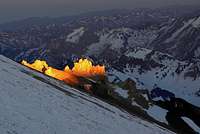
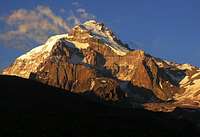


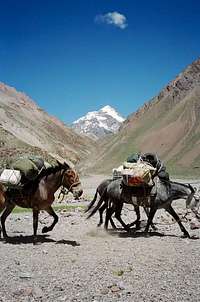

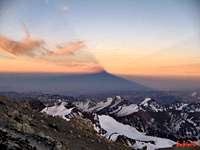
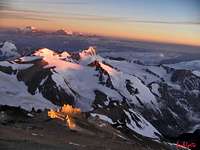
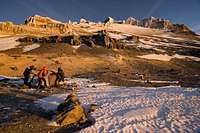

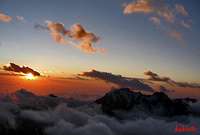
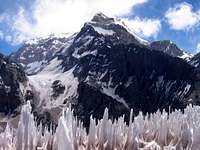


T. White - Nov 20, 2017 7:29 pm - Voted 10/10
A bit of good newsChile no longer charges the $140 reciprocity fee for Americans to enter by plane, as the U.S. has dropped the tourist visa requirement for Chileans. One less issue if traveling via Santiago...
William Marler - Nov 21, 2017 3:12 pm - Hasn't voted
Re: A bit of good newsThanks for the update. Cheers William
homicide133 - May 3, 2018 12:18 pm - Hasn't voted
Re: A bit of good newsThat's good to know. Hiked the W in Torres del Paine NP and remember paying that fee once we landed at airport. Looking to climb Aconcagua possibly this winter (Dec 2018-Jan 2019)
northfacejmb - Jun 23, 2018 7:43 pm - Hasn't voted
Online MapHere is a topo map I created for the area seeing that there weren't any good ones online. If it's useful to you, paypal me a couple bucks: https://caltopo.com/m/5DCC
atavist - Jan 14, 2019 5:44 am - Hasn't voted
permit costCosts have gone up. Check the official Parque Provincial Aconcagua website for current prices.
William Marler - Jan 21, 2019 12:42 pm - Hasn't voted
Re: permit costHi Thanks. I figured they would be higher. Ive updated the information with what they charge non-Argentines and non-South Americans and added a link to the pdf which explains the cost for all supported and unsupported. Thanks again and cheers William
jmatthew01 - Aug 6, 2019 10:47 pm - Hasn't voted
Acomara Aconcagua - Classic easement Aconcagua TrekClassic easement Aconcagua Trek Our Aconcagua trek was rewarding and of a great experience. I would like to thank and recommend them due to their very well organized plan. The entire trip was set in a "rhythm" that was well-intended. Their Guides were amazing- A+ for their skill, knowledge, cheerfulness, great narrator, and being all-round good company. The highest walk across the globe, the trip to Aconcagua is just a test to try out aptitude for altitude. Trekking this whimsical mountain, Aconcagua needs more than well stratagem with following the plan in total acquiescence. Tough days, relaxing days. The chance to gaze stars and sleep under the open sky are few of the things that will stay life-long. Take your hiking shoes with Acomora, and you will be fascinated by seeing Horcones valley and relaxing ambiance of the base camp. Our first trek trip and prepared for the next with ACOMORA ACONCAGUA EXPEDITION and recommend anyone considering the MONT ACONCAGUA trek "just do it"- with them. You can reach them at (+54-9-261) 618-1000 for international tourists and also you can mail them to info@acomara.com, without any exhaustion. Exceptional tour plan and my thanks to their wonderful guides for their care and kitchen prowess. Exceptional and stunning vistas- Aconcagua trek Be prepared for the epic views and breathtaking rides to Aconcagua with ACOMORA,- Yes! we have done it and now it is your turn to have enthralling hiking views with the supremely talented, helpful, knowledgeable mountaineers. The entire trip was framed to deliver amazing food, and experience surrounding environment, piercing blue sky, and majestic base camp. Even more, you will be thrilled with the defined aboriginal culture made song-line while heading to the summit. Surely, it is recommended by my friends and, I will do the same, due to their conveniently located base camp, enthusiastic service provider, impressive extras and promising views, along with delectable wholesome food. How can I forget to mention the balanced walking tour, covered with an impressive environment and the campfire under the Starlit night skies? Each day was unique and denote learning phase. The journey builds insights and allowed to know more people and their culture. With NORMAL ROUTE, my Aconcagua climbing expedition was impeccable. Well recommended to those who like to cover the Aconcagua hike for the multi-day tour and plunge into stunning views of Andes. Get the most from your Aconcagua trek with Acomora. Contact them at (+54-9-261) 618-1000 or simply visit their site aconcaguaexpeditions.com for more references. Indubitably, you will get a complete inspiring, absorbing, heightened fun-filled walk and super support system that further alleviates your journey with logistical responsibilities. For more details visit at https://aconcaguaexpeditions.com/
jmatthew01 - Oct 24, 2019 2:53 am - Hasn't voted
Amazing journey Experience with ACOMARAMe and my friend have done the Normal Route, Aconcagua with Acomara Aconcagua Expedition to trek all across the Andes. Had a great experience, really enjoyed good food and their generous services provided by the expert guides, porters and cook. I must thank the entire team and a big thanks to the porters who were the greatest strength to carry our essentials all through the paths to the Aconcagua summit. Highly recommended trekking !! I will always refer their name to all the travellers who are enthusiasts enough to explore the extremity of the unbeatable altitude of the Aconcagua. There’s absolutely no way I would have successfully made summit expedition without the encouragement of the Acomara team and expert guidance of the robust climbers. They took great care and observed each of us minutely. I surely recommend them for your Aconcagua trek, or climb as they are experienced to take you to any level. Be it Valle de las Vacas, and the Valle de los Horcones through Polish Glacier Traverse Route or explore spectacular views and extreme spots through Route Guanacos Route and Polish Glacier Route. To conclude, the trek to Aconcagua through Normal Route, Aconcagua with Acomara was amazing and memorable If you have any plan for adventure pr planning to trek or climb, Contact Acomara Aconcagua Expedition at (+54-9-261) 618-1000 and also browse their page https://aconcaguaexpeditions.com/ for further support.